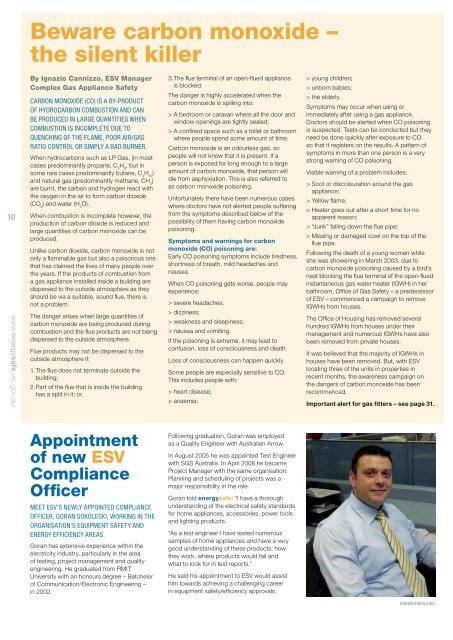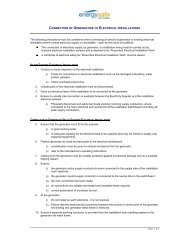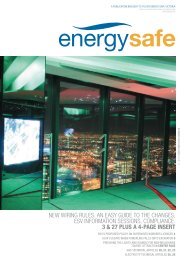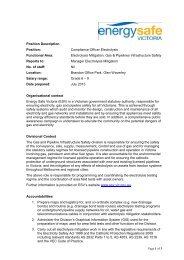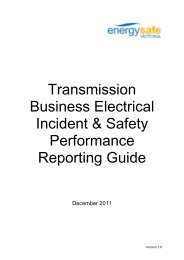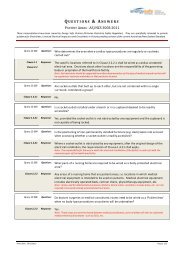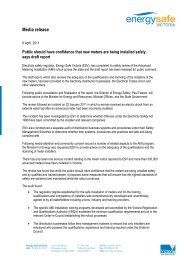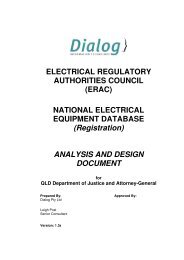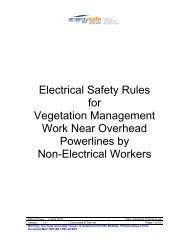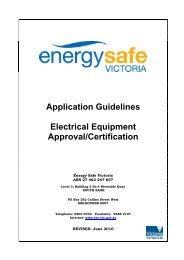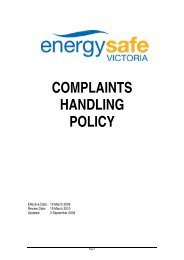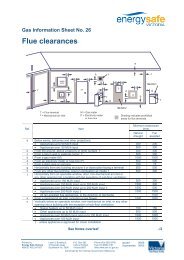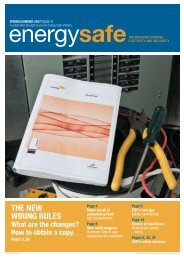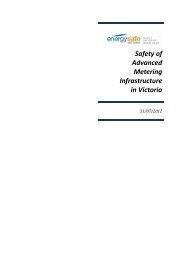Beware carbon monoxide –the silent killer10www.energysafe.vic.gov.auBy Ignazio Cannizzo, ESV ManagerComplex Gas Appliance <strong>Safe</strong>tyCarbon monoxide (CO) is a by-productof hydrocarbon combustion and canbe produced in large quantities whencombustion is incomplete due toquenching of the flame, poor air/gasratio control or simply a bad burner.When hydrocarbons such as LP Gas, (in mostcases predominantly propane, C 3H 8, but insome rare cases predominantly butane, C 4H 10)and natural gas (predominantly methane, CH 4)are burnt, the carbon and hydrogen react withthe oxygen in the air to form carbon dioxide(CO 2) and water (H 2O).When combustion is incomplete however, theproduction of carbon dioxide is reduced andlarge quantities of carbon monoxide can beproduced.Unlike carbon dioxide, carbon monoxide is notonly a flammable gas but also a poisonous onethat has claimed the lives of many people overthe years. If the products of combustion froma gas appliance installed inside a building aredispersed to the outside atmosphere as theyshould be via a suitable, sound flue, there isnot a problem.The danger arises when large quantities ofcarbon monoxide are being produced duringcombustion and the flue products are not beingdispersed to the outside atmosphere.Flue products may not be dispersed to theoutside atmosphere if:1. The flue does not terminate outside thebuilding;2. Part of the flue that is inside the buildinghas a split in it; or,3. The flue terminal of an open-flued applianceis blocked.The danger is highly accelerated when thecarbon monoxide is spilling into:> > A bedroom or caravan where all the door andwindow openings are tightly sealed;> > A confined space such as a toilet or bathroomwhere people spend some amount of time.Carbon monoxide is an odourless gas, sopeople will not know that it is present. If aperson is exposed for long enough to a largeamount of carbon monoxide, that person willdie from asphyxiation. This is also referred toas carbon monoxide poisoning.Unfortunately there have been numerous caseswhere doctors have not alerted people sufferingfrom the symptoms described below of thepossibility of them having carbon monoxidepoisoning.Symptoms and warnings for carbonmonoxide (CO) poisoning are:Early CO poisoning symptoms include tiredness,shortness of breath, mild headaches andnausea.When CO poisoning gets worse, people mayexperience:> > severe headaches;> > dizziness;> > weakness and sleepiness;> > nausea and vomiting.If the poisoning is extreme, it may lead toconfusion, loss of consciousness and death.Loss of consciousness can happen quickly.Some people are especially sensitive to CO.This includes people with:> > heart disease;> > anaemia;> > young children;> > unborn babies;> > the elderly.Symptoms may occur when using orimmediately after using a gas appliance.Doctors should be alerted when CO poisoningis suspected. Tests can be conducted but theyneed be done quickly after exposure to COso that it registers on the results. A pattern ofsymptoms in more than one person is a verystrong warning of CO poisoning.Visible warning of a problem includes:> > Soot or discolouration around the gasappliance;> > Yellow flame;> > Heater goes out after a short time for noapparent reason;> > “Junk” falling down the flue pipe;> > Missing or damaged cowl on the top of theflue pipe.Following the death of a young woman whileshe was showering in March <strong>20</strong>03, due tocarbon monoxide poisoning caused by a bird’snest blocking the flue terminal of the open-fluedinstantaneous gas water heater (IGWH) in herbathroom, Office of Gas <strong>Safe</strong>ty – a predecessorof ESV – commenced a campaign to removeIGWHs from houses.The Office of Housing has removed severalhundred IGWHs from houses under theirmanagement and numerous IGWHs have alsobeen removed from private houses.It was believed that the majority of IGWHs inhouses have been removed. But, with ESVlocating three of the units in properties inrecent months, the awareness campaign onthe dangers of carbon monoxide has beenrecommenced.Important alert for gas fitters – see page 31.Appointmentof new ESVComplianceOfficerMeet ESV’s newly appointed ComplianceOfficer, Goran Sokoleski, working in theorganisation’s equipment safety andenergy efficiency areas.Goran has extensive experience within theelectricity industry, particularly in the areaof testing, project management and qualityengineering. He graduated from RMITUniversity with an honours degree – Batchelorof Communication/Electronic Engineering –in <strong>20</strong>02.Following graduation, Goran was employedas a Quality Engineer with Australian Arrow.In August <strong>20</strong>05 he was appointed Test Engineerwith SGS Australia. In April <strong>20</strong>08 he becameProject Manager with the same organisation.Planning and scheduling of projects was amajor responsibility in the role.Goran told energysafe: “I have a thoroughunderstanding of the electrical safety standardsfor home appliances, accessories, power toolsand lighting products.“As a test engineer I have tested numeroussamples of home appliances and have a verygood understanding of these products, howthey work, where products would fail andwhat to look for in test reports.”He said his appointment to ESV would assisthim towards achieving a challenging careerin equipment safety/efficiency approvals.Goran Sokoleski.
The SunAlways Shines…or Does It?Enhancingyour business.Advancingour industry.The electrical industry is seeing a rapid growthin new technologies that whilst they can be seenas exciting opportunities for contractors, alsopresent a minefield of challenges.The growth in grid connected PV systems andthe rapid growth of lighting options presentedby the new LED technologies are just two areasthat are seen as an emerging market for electricalcontractors.But both present some hidden dangers for theunwary.NECA reported in its May edition of its magazinethat the rollout of the new smart meters andpotential changes to customer tariffs has led tomany of the grid connected systems that havebeen installed, either not being connected, or notproviding the customer the financial returns thatthey expected.From a lighting perspective, the market is nowseeing a proliferation of LED lamps that arepromoted with a range of features and benefitsthat may or may not be completely factuallyaccurate or suitable in all installations.The issue is what does the contractor do?In very simple terms, get the right information.Lighting is a complex issue, but the first step isto understand the technical and regulatory issuessurrounding lighting before making the decisionof what type of product to use.Ian Johnson, who trains the electricians whoundertake the two lighting courses that havebeen developed by NECA as part of their highlysuccessful EcoSmart Electricians Program, saysthat the new standards that have been set bythe Building Code of Australia now require therelationship between energy efficiency and lightoutput to be very closely related. “Whilst thereis a lot of new product on the market,understanding its application is critical”.In solar installations the issue of tariff changeis critical, especially from the customer’sperspective. One of the prime marketing thrustsof the PV industry and the government has beenthat generating your own electricity will save youmoney. And it does, but not as much as manythink it will. The reason is that there are a numberof mitigating factors that come into play. Whilstwe have the net tariff model, understanding thatis an issue in itself. There is also now theadditional factor of tariff changes once thenew meter is installed.For solar consumers who have two meters –one of which is dedicated to electric hot water,space heating or in-slab heating that is chargedat an off-peak rate, these meters will need tobe replaced by a single new interval meter tomeasure feed-in power every 30 minutes, whichis a prerequisite for customers wishing to connecttheir solar PV system to the grid and benefit fromeither a standard or premium feed-in tariff offer.In layman’s terms, this means … wait for it …NO MORE OFF-PEAK BENEFITSJeff Salton, from Salton Media Services whoconducted some research for NECA on thisissue said, “ … a lot of confusion surrounds thebenefits/penalties associated with PV systemsinstalled into homes and some small businesses.Many consumers who have chosen the PremiumFeed-in Tariff (PFiT) are finding out, after theevent, that they have sacrificed their off-peak tariffand are solely on a time of use (ToU) tariff. PFiTcustomers can sell back their excess energy atroughly three times what they would buy it forfrom the energy retailer (60c per kWh).“However, owners of larger homes, or householdswith many occupants will find that the standard1.5kW system they have had installed will rarelygenerate any excess energy to feed back into thenetwork because their household uses at leastthat much. In order to gain any payment, theywould practically have to leave home for a monthand turn off every fridge, freezer, swimming poolpump, security system, etc, for the duration.If they’ve installed a larger system – up to 5kWto still be eligible for the PFiT scheme, that’s adifferent story, but the cost of these systems isoften prohibitive for many consumers and thereturn on investment can be even longer.”In a lot of cases we see a scenario that can haveup to five players. The end customer, the solarsales company, the contractor, the electricityretailer and the electricity distributor all who havesome role to play in this contract. Rarely is it aco-ordinated and open relationship as it shouldbe, with everyone coming out a winner.Because of the processes involved, the twoparties that stand to lose the most are typicallythe customer and the contractor.So what can be done? NECA <strong>Victoria</strong> CEO, PhilipGreen, says that there seems to be an overalllack of information flow. “When we talk to theindividual players such as the electricity retailersand electricity distributors they say that they havethat information available but the contractors inmost instances do not access it.” This, he says,creates many of the issues that have begun toemerge, many finishing up as complaints lodgedwith the <strong>Energy</strong> Ombudsman.Philip says that NECA have taken a proactive rolein this with its involvement in a working group thathas been established by the <strong>Energy</strong> Ombudsmanthat comprises industry representatives fromthe retailers, distributors and industry to activelyaddress the issues of information and educationfor the Contractors. However, “we encourageboth the consumer and contractor to checkthat ALL the necessary paperwork has beencompleted to make the most of any advantageif their solar power generation units.”He says that whilst there is considerable workcurrently being done to make the processes farmore transparent and understandable to boththe consumers and contractors, the electricalcontractors should make themselves aware ofwhat the processes are so that they can avoidany undue issues with their customers overtariff changes.What is a feed-in tariff?A feed-in tariff is a payment to households,community organisations and small businessesfrom power companies for electricity that is‘fed back into’ the power grid. Some customerswho install small-scale renewable energysystems can sometimes produce more energythan they can use and, if connected to thepower grid, can feed this electricity back intothe grid at a price no less than $0.60 per kWh.<strong>Victoria</strong> has two levels of feed-in tariffs forhouseholds and small businesses – standardand premium. Payments are dependent onthe type of renewable energy that they aregenerating, the size of the system and howmuch excess energy they feed in.The premium feed-in tariff is availablefor households, as well as communityorganisations and small businesses with energyconsumption of less than 100MWh a year, andwith small-scale solar photovoltaic (PV) systemswith a capacity of up to 5kW. In <strong>Victoria</strong>, thepremium rate is fixed at a minimum of $0.60per kWh for power fed back into the grid. Thisis more than three times the standard retail rateconsumers pay for electricity.The standard feed-in tariff is available forpeople producing power for their homes orsmall businesses using renewable energysystems with a capacity of up to 100kW. Thisincludes people generating their own wind,solar, hydro or biomass power. The excesspower fed back into the grid is reimbursed(credited) at the same retail rate charged forelectricity consumed.Both tariffs are currently in operation in <strong>Victoria</strong>.Net tariff – ‘net’ feed-in tariff is applicable in<strong>Victoria</strong>. It encourages people to better managetheir electricity usage – especially at times ofpeak load such as hot summer days. It doesnot require national agreement.Gross tariff – Currently, some states, likeNSW, favour this system. Gross feed-in tariffsreimburse PV owners for EVERY kWh theygenerate, not just the excess power they returnto the grid.Opt in – Some energy retailers don’tautomatically begin crediting customers withPfiT installations until the home-owner signsan “opt in” form, for which they must firstapply. Nor will they necessarily backdatepayments from the when the systemwas operational.11Autumn/Winter <strong><strong>20</strong>10</strong> <strong>ISSUE</strong> <strong>20</strong>


